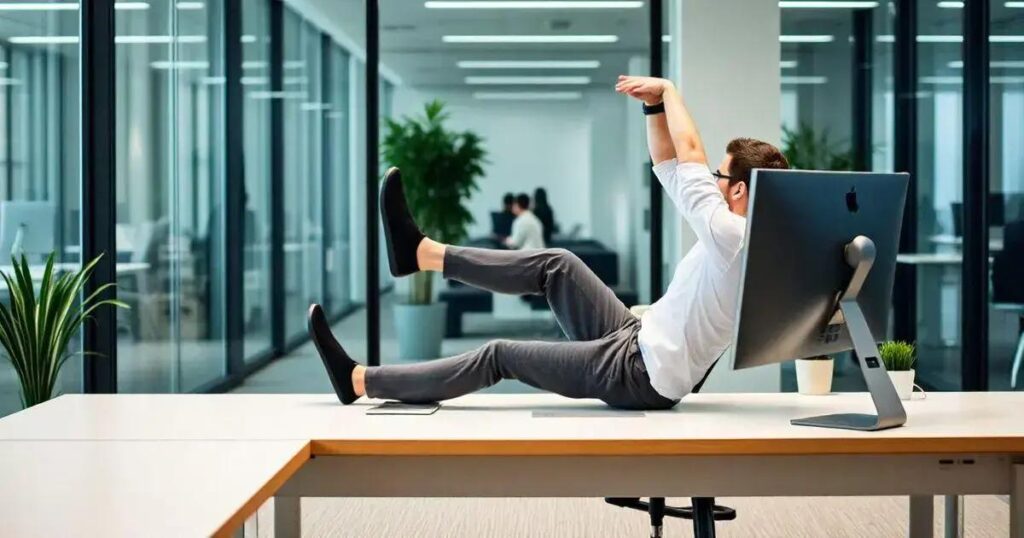The benefits of intermittent stretching for desk workers include improved circulation, reduced muscle tension, enhanced flexibility, and a lower risk of chronic conditions. By incorporating practical stretching techniques into your daily routine, such as setting reminders and involving coworkers, you can significantly improve your overall well-being and productivity at work.
Desk workers often spend hours sitting in front of a computer, which can lead to discomfort and long-term health issues. The benefits of intermittent stretching for desk workers cannot be overstated. By incorporating regular stretching into your work routine, you can enhance your physical well-being and boost productivity. This article will delve into what intermittent stretching is, its health benefits, effective techniques, and how to easily incorporate it into your daily schedule.
Understanding Intermittent Stretching

Intermittent stretching is a simple yet effective way to improve flexibility and reduce muscle tension, especially for those who sit at a desk for long periods. Incorporating short stretches throughout your day can counteract the negative effects of prolonged sitting. This practice involves performing stretching exercises at intervals, rather than in a single prolonged session.
What is Intermittent Stretching?
Intermittent stretching refers to the practice of integrating brief stretching breaks into your daily activities. It enhances circulation and helps loosen tight muscles. Unlike static stretching, which is done for longer periods, intermittent stretching can be done quickly without disrupting your workflow.
Why It’s Beneficial for Desk Workers
Desk workers often experience stiffness or discomfort due to extended periods of sitting. Intermittent stretching can reduce these symptoms, making you feel more comfortable and focused. It is especially useful for relieving tension in the neck, shoulders, and lower back.
Implementing Intermittent Stretching
To start, schedule short stretching sessions every hour. You can set a timer or use reminders on your phone. During each session, take 2 to 5 minutes to perform stretches that target your major muscle groups. This practice encourages movement and keeps your muscles energized.
In summary, understanding intermittent stretching is crucial for desk workers looking to enhance their comfort and productivity. By taking regular stretching breaks, you can greatly improve your overall well-being and reduce the risks associated with sedentary behavior.
Health Benefits for Desk Workers

Desk workers can often experience health issues due to prolonged sitting. The benefits of intermittent stretching can help combat these problems. Stretching for just a few minutes each hour improves blood flow and reduces tension in your muscles.
Improved Circulation
When you sit for long periods, blood circulation can slow down. Regular stretching encourages blood flow, which nourishes your muscles and helps prevent fatigue. Increased circulation can also enhance your focus and productivity.
Reduced Muscle Tension
Long periods of sitting lead to tight muscles, especially in the neck, shoulders, and lower back. Intermittent stretching helps to relieve this tension, making you feel more relaxed and comfortable throughout your workday.
Enhanced Flexibility and Posture
Incorporating stretching into your routine can increase flexibility. Improved flexibility not only helps you move better but also aids in maintaining good posture. Good posture prevents back pain and discomfort, improving overall health.
Reduced Risk of Chronic Conditions
Sitting for too long can contribute to health conditions like obesity, heart disease, and diabetes. Regular stretching breaks can help reduce these risks by promoting a more active lifestyle, even during work hours.
Practical Stretching Techniques

Incorporating practical stretching techniques into your work routine can make a big difference in how you feel throughout the day. Here are some simple yet effective stretches that desk workers can do right at their desks.
Neck Stretch
To relieve tension in your neck, tilt your head toward one shoulder and hold for 15-30 seconds. Switch sides and repeat. This stretch helps reduce stiffness and improve mobility.
Shoulder Rolls
Shoulder rolls are great for relieving tightness. Sit or stand up straight, then roll your shoulders forward in a circular motion ten times. Switch to rolling them backward for another ten times. This technique keeps your shoulders relaxed.
Wrist and Finger Stretch
Desk workers often experience wrist fatigue. Extend one arm in front with your palm facing up. With your other hand, gently pull back on your fingers for 15-30 seconds. Repeat with the other hand. This stretch relieves tension in your wrists and fingers.
Seated Torso Twist
To stretch your spine and improve flexibility, sit up straight and twist your torso to one side. Hold the back of your chair for support and hold for 15-30 seconds. Return to the center and repeat on the other side. This stretch enhances spinal mobility.
Incorporating Stretching into Your Routine

Incorporating stretching into your daily routine doesn’t have to be complicated. Here are some easy ways to ensure you are consistently stretching throughout your workday.
Set Reminders
One effective way to remember to stretch is to set reminders on your phone or computer. Consider setting a timer to go off every hour. This will prompt you to take a brief break and perform some stretches.
Create a Stretching Schedule
Design a schedule that includes specific stretching times. For example, plan to stretch at the start of your day, during lunch, and before finishing work. Sticking to a routine helps make stretching a habit.
Use Breaks Wisely
Utilize your breaks for short stretching sessions. Instead of scrolling through your phone during breaks, dedicate a few minutes to stretching. This will not only refresh your mind but also help your body feel better.
Involve Colleagues
Encourage your coworkers to join in on stretching breaks. You can create a fun office culture around stretching. Organizing group stretching sessions can make it more enjoyable and ensure everyone stays motivated.
Incorporating Stretching into Your Daily Life
The benefits of intermittent stretching for desk workers are significant, helping to combat the negative health effects of prolonged sitting. By understanding and implementing practical stretching techniques, you can enhance your well-being and productivity.
Start by setting reminders and establishing a consistent stretching schedule. Involve your coworkers to create a supportive stretching culture in your workplace. These simple steps can make a big difference in how you feel throughout the workday.
Ultimately, making stretching a regular part of your routine not only improves your physical health but also contributes to a more enjoyable and productive work environment.
FAQ – Frequently Asked Questions about Intermittent Stretching for Desk Workers
What is intermittent stretching?
Intermittent stretching refers to the practice of integrating short stretching breaks into your work routine to improve flexibility and reduce muscle tension.
How often should I stretch during the workday?
It is recommended to take stretching breaks every hour for about 2 to 5 minutes to counteract the effects of prolonged sitting.
What are some easy stretching techniques I can do at my desk?
Simple techniques include neck stretches, shoulder rolls, wrist and finger stretches, and seated torso twists, all of which are quick and effective.
Why is stretching important for desk workers?
Stretching helps improve circulation, reduce muscle tension, enhance flexibility, and lower the risk of developing chronic conditions associated with prolonged sitting.
How can I remember to stretch during the day?
Setting reminders on your phone or creating a stretching schedule can help you remember to take regular stretching breaks throughout the day.
Is it beneficial to stretch with coworkers?
Yes, involving coworkers in stretching can create a fun and supportive office culture, making it easier and more enjoyable to incorporate stretching into your routine.













